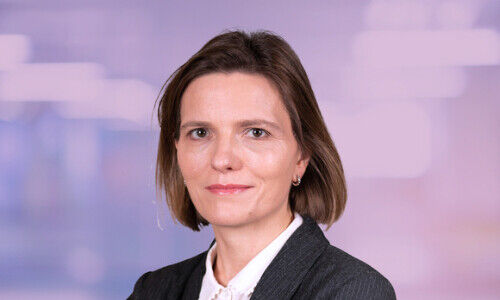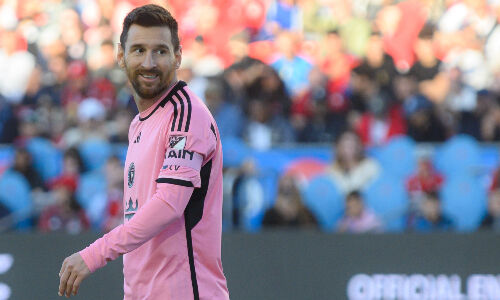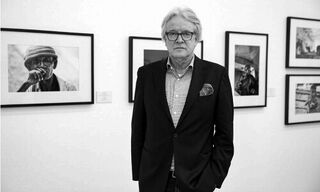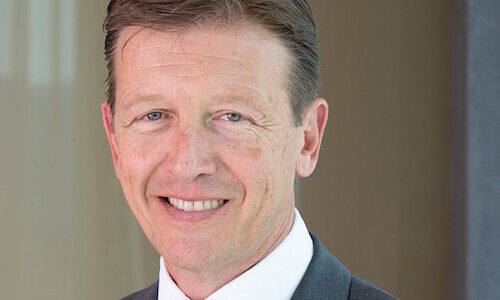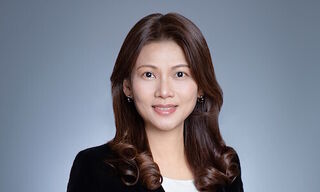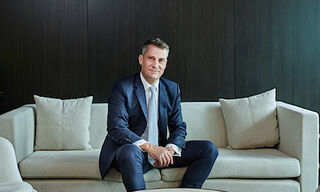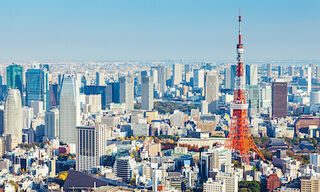Nadège Dufossé: «Will the Gold Rush Continue?»
The recent surge in gold prices has been historically significant, especially as it defies the traditional relationship between this precious metal and other asset classes, Nadège Dufossé writes in her article on finews.first. Will this trend continue?
finews.first is a forum for authors to comment on economic and financial topics.
The price of gold has risen more than 17 percent since the beginning of the year, making it one of the best-performing assets this year. After fluctuating between $1,800 and $2,000 in 2023, the price of gold surged in March and April of 2024, quickly reaching $2,400.
This behavior has been widely discussed. Historic in its scale and speed of movement, it is especially notable because it contravenes the historically observed relationship between gold and other asset classes. The rise in gold occurred at a time when real interest rates were rising, the dollar was strengthening, and risk assets continued their ascent early in the year.
«Does not generate yield»
The link between real interest rates and gold has been broken since early 2022. Historically, the price of gold has been inversely correlated with changes in US real interest rates, and this relationship has worked well at least since 2006. From a fundamental point of view, this is because, being a real asset that does not generate yield, holding gold becomes more costly as positive real rates rise.
Similarly, a stronger dollar usually penalizes dollar-denominated commodities (including gold) because it makes them more expensive for non-US investors (most of whom are gold investors). The rise in the dollar index by more than 4 percent this year has also not been an obstacle to gold’s advance. Finally, gold is often perceived as a safe haven and tends to perform well in times of stress, which has not been the case this year: US equity volatility has returned to its lows (VIX index close to 12) and credit spreads have tightened significantly. So, how can the exceptional performance of gold be explained? And, more importantly, is it sustainable?
«Chinese consumers have channeled part of their savings into gold purchases»
Global demand for gold by central banks has doubled since 2022, from 11 percent of total gold demand in 2021 to 23 percent in 2023. This trend continued in the first quarter of this year. Investments in bars and coins, as well as ETFs, which had increased significantly in 2020 (the year of COVID-19), have since decreased significantly.
China, being the world’s largest gold producer (10 percent of mining production), is also the largest importer (20 percent of demand). The People’s Bank of China (PBOC) increased its gold reserves in 2022-2023, although the total amount remains uncertain, as it is not required to transparently publish all its gold purchases. Similarly, Chinese consumers appear to have channeled part of their savings into gold purchases, although the exact amount is unknown.
Overall, if all central banks in emerging countries reached a minimum of 10 percent of their reserves in gold, global gold demand would grow by more than 75 percent percent. This structural factor seems likely to continue. When surveyed in 2023, 23 percent of central banks intended to increase their gold reserves in the next 12 months.
This impetus to diversify central bank reserves accelerated after COVID-19 and the start of the war in Ukraine. It is probably due to the perception of increased financial risk, linked, on the one hand, to the rise in the US deficit and, on the other, to the sanctions unilaterally decided by the United States against Russia (including the freezing of $300 billion in reserves).
«The risk of a return of inflation is also favorable for gold»
On the supply side, the trend is relatively stable, with annual production hovering around 3,000 tons each year, but demand prospects seem quite good. We anticipate a slightly more favorable macroeconomic context. Real interest rates are likely to remain stable at best, or even decline slightly due to the economic slowdown and the Fed’s initial rate cuts, which should support the price of gold. Additionally, the risk of a return of inflation in the opposite scenario is also favorable for gold, as a real asset, it protects against excessive inflation.
The more structural factors that have driven the increase in central bank purchases, especially in emerging countries, will persist. Geopolitical risks remain present, and the US deficit shows no signs of reducing.
«In a multi-asset portfolio, gold is interesting in terms of diversification»
However, as illustrated by the previous chart, central bank demand for gold has historically been quite volatile, as has investment (including ETFs). These two types of demand could accelerate (increasing central bank gold reserves and attracting financial investors to gold), which is our preferred scenario, but visibility on their short-term evolution remains limited. In the medium and long term, the upward trends in gold demand seem more clearly positive.
In a multi-asset portfolio, our simulations show that gold is interesting in terms of diversification, as it has little correlation with the performance of equity or fixed income. Gold also reacts positively to market tensions. A structural portfolio exposure of 3 to 5 percent to gold, along with other alternative assets, improves the risk/return profile of diversified funds.
Nadège Dufossé has been the Global Head of Multi-Asset at Candriam since 2021. She began her career as a sell-side Equity Analyst at Exane BNP Paribas in Paris in 1997. In 2007 she joined Candriam as a Multi-Asset Fund Manager based in Luxembourg. In 2011 she became a Senior Asset Allocation Strategist. She subsequently took the role of Head of Asset Allocation at Candriam in 2014. She graduated from HEC Paris. She is a CFA Charterholder and holds a financial analyst diploma from the French Society of Financial Analysts.
Previous contributions: Rudi Bogni, Peter Kurer, Rolf Banz, Dieter Ruloff, Werner Vogt, Walter Wittmann, Alfred Mettler, Robert Holzach, Craig Murray, David Zollinger, Arthur Bolliger, Beat Kappeler, Chris Rowe, Stefan Gerlach, Marc Lussy, Nuno Fernandes, Richard Egger, Maurice Pedergnana, Marco Bargel, Steve Hanke, Urs Schoettli, Ursula Finsterwald, Stefan Kreuzkamp, Oliver Bussmann, Michael Benz, Albert Steck, Martin Dahinden, Thomas Fedier, Alfred Mettler, Brigitte Strebel, Mirjam Staub-Bisang, Nicolas Roth, Thorsten Polleit, Kim Iskyan, Stephen Dover, Denise Kenyon-Rouvinez, Christian Dreyer, Kinan Khadam-Al-Jame, Robert Hemmi, Anton Affentranger, Yves Mirabaud, Katharina Bart, Frédéric Papp, Hans-Martin Kraus, Gerard Guerdat, Mario Bassi, Stephen Thariyan, Dan Steinbock, Rino Borini, Bert Flossbach, Michael Hasenstab, Guido Schilling, Werner E. Rutsch, Dorte Bech Vizard, Katharina Bart, Maya Bhandari, Jean Tirole, Hans Jakob Roth, Marco Martinelli, Thomas Sutter, Tom King, Werner Peyer, Thomas Kupfer, Peter Kurer, Arturo Bris, Frederic Papp, James Syme, Dennis Larsen, Bernd Kramer, Armin Jans, Nicolas Roth, Hans Ulrich Jost, Patrick Hunger, Fabrizio Quirighetti, Claire Shaw, Peter Fanconi, Alex Wolf, Dan Steinbock, Patrick Scheurle, Sandro Occhilupo, Will Ballard, Nicholas Yeo, Claude-Alain Margelisch, Jean-François Hirschel, Jens Pongratz, Samuel Gerber, Philipp Weckherlin, Anne Richards, Antoni Trenchev, Benoit Barbereau, Pascal R. Bersier, Shaul Lifshitz, Klaus Breiner, Ana Botín, Martin Gilbert, Jesper Koll, Ingo Rauser, Carlo Capaul, Markus Winkler, Thomas Steinemann, Christina Boeck, Guillaume Compeyron, Miro Zivkovic, Alexander F. Wagner, Eric Heymann, Christoph Sax, Felix Brem, Jochen Moebert, Jacques-Aurélien Marcireau, Ursula Finsterwald, Michel Longhini, Stefan Blum, Zsolt Kohalmi, Nicolas Ramelet, Søren Bjønness, Gilles Prince, Salman Ahmed, Peter van der Welle, Ken Orchard, Christian Gast, Jeffrey Bohn, Juergen Braunstein, Jeff Voegeli, Fiona Frick, Stefan Schneider, Matthias Hunn, Andreas Vetsch, Fabiana Fedeli, Kim Fournais, Carole Millet, Swetha Ramachandran, Thomas Stucki, Neil Shearing, Tom Naratil, Oliver Berger, Robert Sharps, Tobias Mueller, Florian Wicki, Jean Keller, Niels Lan Doky, Johnny El Hachem, Judith Basad, Katharina Bart, Thorsten Polleit, Peter Schmid, Karam Hinduja, Zsolt Kohalmi, Raphaël Surber, Santosh Brivio, Mark Urquhart, Olivier Kessler, Bruno Capone, Peter Hody, Michael Bornhaeusser, Agnieszka Walorska, Thomas Mueller, Ebrahim Attarzadeh, Marcel Hostettler, Hui Zhang, Michael Bornhaeusser, Reto Jauch, Angela Agostini, Guy de Blonay, Tatjana Greil Castro, Jean-Baptiste Berthon, Marc Saint John Webb, Dietrich Goenemeyer, Mobeen Tahir, Didier Saint-Georges, Serge Tabachnik, Vega Ibanez, David Folkerts-Landau, Andreas Ita, Michael Welti, Fabrizio Pagani, Roman Balzan, Todd Saligman, Stuart Dunbar, Carina Schaurte, Birte Orth-Freese, Gun Woo, Lamara von Albertini, Ramon Vogt, Andrea Hoffmann, Niccolò Garzelli, Darren Williams, Benjamin Böhner, Mike Judith, Jared Cook, Henk Grootveld, Roman Gaus, Nicolas Faller, Anna Stünzi, Thomas Höhne-Sparborth, Fabrizio Pagani, Guy de Blonay, Jan Boudewijns, Sean Hagerty, Alina Donets, Sébastien Galy, Roman von Ah, Fernando Fernández, Georg von Wyss, Stefan Bannwart, Andreas Britt, Frédéric Leroux, Nick Platjouw, Rolando Grandi, Philipp Kaupke, Gérard Piasko, Brad Slingerlend, Dieter Wermuth, Grégoire Bordier, Thomas Signer, Gianluca Gerosa, Christine Houston, Manuel Romera Robles, Fabian Käslin, Claudia Kraaz, Marco Huwiler, Lukas Zihlmann, Sherif Mamdouh, Harald Preissler, Taimur Hyat, Philipp Cottier, Andreas Herrmann, Camille Vial, Marcus Hüttinger, Serge Beck, Alannah Beer, Stéphane Monier, Ashley Simmons, Lars Jaeger, Shanna Strauss-Frank, Bertrand Binggeli, Marionna Wegenstein, George Muzinich, Jian Shi Cortesi, Razan Nasser, Nicolas Forest, Joerg Ruetschi, Reto Jauch, Bernardo Brunschwiler, Charles-Henry Monchau, Philip Adler, Ha Duong, Teodoro Cocca, Beat Wittmann, Jan Brzezek, Florin Baeriswyl, Nicolas Mousset, Beat Weiss, Pascal Mischler, Andrew Isbester, Konrad Hummler, Jan Beckers, Martin Velten, Katharine Neiss, Claude Baumann, Daniel Roarty, Kubilay Yalcin, Robert Almeida, Karin M. Klossek, Marc Taverner, Charlie T. Munger, Daniel Kobler, Patrick Stauber, Colin Vidal, Anna Rosenber, Judith Wallenstein, Adriano Lucatelli, Daniel Goleman, Val Olson, Brice Prunas, Francesco Magistra, Brigitte Kaps, Frances Weir, Luis Maldonado, Francesco Magistra, Nadège Lesueur-Pène, Massimo Pedrazzini, Eric Sarasin, David Ellis, Dina Ting, Christopher Gannatti, Shaniel Ramjee, Mihkel Vitsur, Nannette Hechler-Fayd’herbe, Ralph Ebert, Chris Cottorone, Francesco Mandalà, Mariolina Esposito, Maryann Umoren Selfe, Dominique Gerster, Marc Arand, and Christian Kälin.

